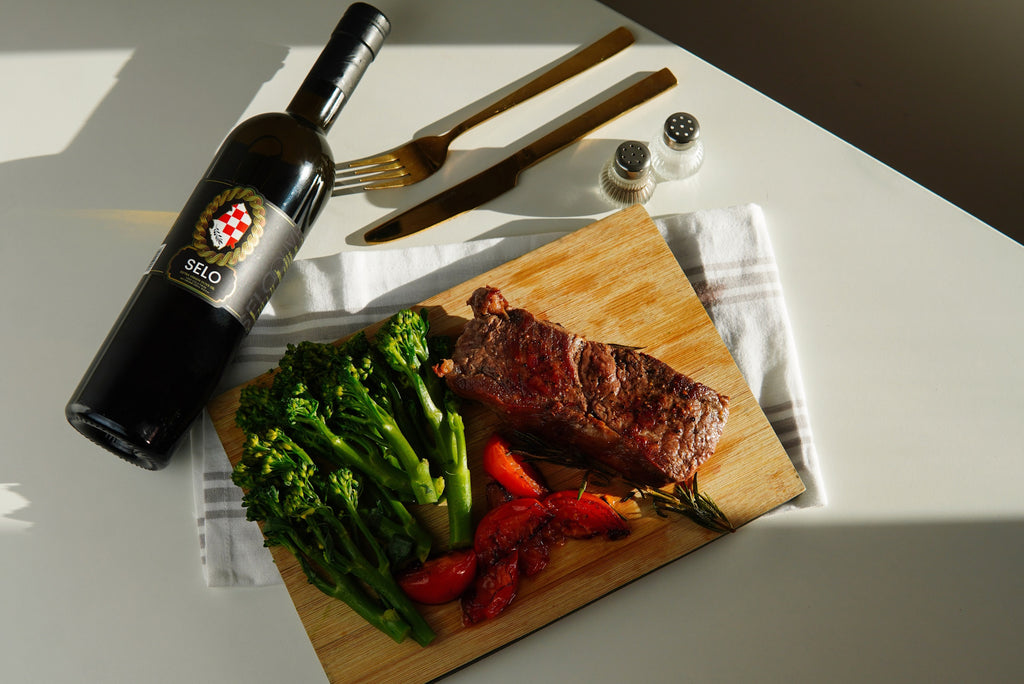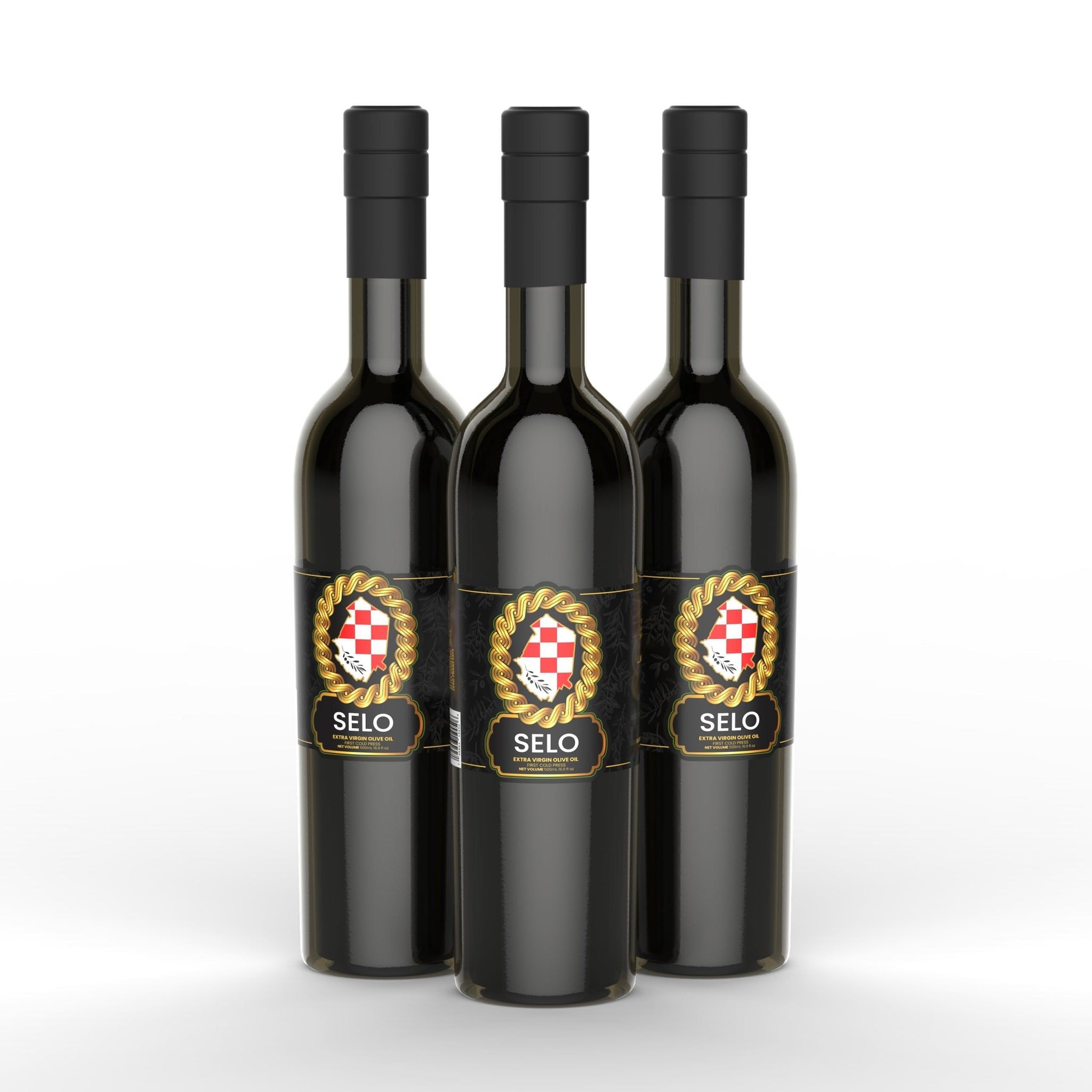There's something inherently satisfying about a perfectly cooked steak, especially when it's been seared to perfection with the finest olive oil. Selo Croatian Olive Oil, with its distinct flavor profile, is the ideal choice for creating an unforgettable steak experience. Here’s a step-by-step guide to achieve that perfect pan-seared steak.
Ingredients:
- 1 high-quality steak (Ribeye or Sirloin)
- 2 tablespoons Selo Croatian Olive Oil
- Salt and pepper, to taste
- 2 tablespoons goat butter
- Fresh rosemary or thyme
- 2 cloves garlic, crushed
Preparation:
-
Marinating: Start by dry marinating your steak. This involves generously seasoning your steak with olive oil, salt, and pepper, then letting it sit at room temperature for about an hour. This process helps in tenderizing the meat and enhancing its flavors. The olive oil, known for its fruity aroma and peppery finish, infuses the steak with a Mediterranean essence that's both unique and tantalizing.
Cooking:
-
Preheat Your Pan: Heat your skillet (preferably cast iron) over high heat. The key to a great sear is a scorching hot pan.
-
Sear the Steak: Once the pan is hot, place your steak in the skillet. Let it sear untouched for about 2-3 minutes on each side, depending on the thickness. This will create a beautiful, rich crust.
-
Lower the Heat and Add Flavor: After the initial sear, reduce the heat to medium. Add the goat butter, rosemary (or thyme), and garlic to the pan. This combination of flavors will give your steak a luxurious and aromatic finish. For a medium-rare steak, continue cooking for about 2-3 minutes per side. Adjust the time based on the thickness of the steak and your preferred doneness.
-
Basting: As the butter melts, tilt the pan slightly and continuously spoon the melted butter and herbs over the steak. This basting process not only flavors the steak but also helps it cook evenly. Regularly basting during this stage ensures that the steak absorbs the rich flavors of the butter and herbs while maintaining moisture for a juicy finish.
-
Resting the Steak: Once your steak reaches the desired level of doneness, remove it from the pan and let it rest for about 5-10 minutes. Resting allows the juices to redistribute, ensuring every bite is as flavorful as the last.
-
Serve: Slice your steak against the grain and serve. The rich flavor of Selo Croatian Olive Oil, combined with the aromatic herbs and the tanginess of goat butter, creates a steak that's simply divine.
Pairings for the Perfect Steak
Enhancing your pan-seared steak experience involves choosing the right pairings. The richness of the steak, combined with the aromatic flavors of rosemary, thyme, garlic, and the luxurious touch of Selo Croatian Olive Oil, opens up a range of possibilities for sides and wines.
Vegetable Sides:
- Garlic Roasted Potatoes: The crispy exterior and fluffy interior of these potatoes make them a hearty companion to the steak.
- Grilled Asparagus: Lightly seasoned and grilled asparagus can add a fresh, slightly charred flavor, balancing the richness of the steak.
- Sautéed Spinach or Swiss Chard: These greens, sautéed with a bit of garlic and olive oil, offer a simple yet flavorful side that complements the steak without overwhelming it.
Starchy Sides:
- Creamy Polenta: A smooth, creamy polenta can serve as a comforting base that pairs wonderfully with the steak’s robust flavors.
- Roasted Root Vegetables: A medley of roasted carrots, parsnips, and beets can add both color and a sweet, earthy flavor to your meal.
- Herb-Infused Mashed Potatoes: Mashed potatoes with a hint of rosemary or thyme can echo the herbs used in the steak preparation.
Wine Pairings:
- Croatian Red Wine: A Plavac Mali, a popular Croatian red wine, known for its bold and robust flavor, can stand up to the rich flavors of the steak.
- Cabernet Sauvignon: This full-bodied red wine, with its deep fruit flavors and hints of spice, is a classic pairing for red meat.
- Syrah/Shiraz: Offering spicy notes and a hint of smokiness, a Syrah or Shiraz complements the charred exterior and herbal notes of the steak.
When it comes to pairing wine, the key is to match the intensity of the wine with that of the dish. A robust steak with rich flavors calls for a wine that can hold its own without being overshadowed. A Croatian wine like Plavac Mali not only complements the dish but also adds an authentic touch, especially when using Croatian olive oil.

Why Use Goat Butter in Your Steak Recipe?
In this recipe, we've chosen to use goat butter for basting, and there's a good reason for this choice beyond its rich flavor. Goat butter, made from goat milk, is considered a healthier alternative to cow's butter for several reasons, particularly when it comes to digestion.
-
Easier Digestion: Goat milk, and consequently goat butter, contains smaller fat molecules and a higher proportion of short-chain and medium-chain fatty acids compared to cow's milk. This makes it easier to digest. For people with sensitive digestive systems or lactose intolerance, goat butter can be a more comfortable option.
-
Nutrient-Rich: Goat milk is rich in essential nutrients like calcium, potassium, and vitamin A. While these nutrients are present in cow's milk as well, goat milk's unique composition allows for better nutrient absorption.
-
Lower Lactose Levels: Goat milk has slightly lower levels of lactose than cow's milk. Though the difference isn't significant, it can sometimes be enough to help people who are mildly lactose intolerant.
-
Distinct Flavor: Goat butter offers a unique, slightly tangy flavor that can add a new dimension to dishes, complementing the rich and savory taste of the steak beautifully.
Incorporating goat butter into this recipe not only adds a gourmet touch but also aligns with a health-conscious approach, offering benefits particularly in terms of digestion. It's a small change that can make a big difference, especially for those sensitive to dairy products.
FAQs:
Q1: Why use Selo Croatian Olive Oil for steak?
A1: Selo Croatian Olive Oil is renowned for its high quality and distinct flavor profile, which adds a unique depth to the steak. Its balance of fruitiness and peppery notes enhances the natural flavor of the meat.
Q2: What is the benefit of marinating a steak?
A2: Marinating, especially with a combination of olive oil and salt, plays a dual role in enhancing your steak. The olive oil coats the steak, helping to lock in moisture and infuse the meat with its rich, fruity flavors. This results in a more succulent and flavorful steak. Additionally, the salt in the marinade works to draw out moisture, which is then reabsorbed, deeply seasoning the steak. This process not only adds flavor but can also aid in tenderizing the meat, ensuring a tender and juicy final product. The use of high-quality olive oil, like Selo Croatian Olive Oil, adds an extra dimension of flavor that sets your steak apart.
Q3: How hot should the pan be for searing steak?
A3: The pan should be very hot, typically on high heat. A hot pan ensures a good sear, which imparts flavor and texture to the steak.
Q4: Can I use other herbs instead of rosemary or thyme?
A4: Absolutely! Feel free to experiment with herbs like sage or oregano. However, rosemary and thyme are classic choices that complement steak wonderfully.
Q5: How do I know when my steak is done?
A5: The best way is to use a meat thermometer. For medium-rare, aim for an internal temperature of 130-135°F (54-57°C). Alternatively, you can use the finger test method to judge doneness by feel.
Q6: Is it necessary to let the steak rest after cooking?
A6: Yes, resting the steak is crucial. It allows the juices to redistribute, ensuring that your steak is juicy and flavorful in every bite.
Q7: What's the best way to store and use leftover Selo Croatian Olive Oil?
A7: Store your olive oil in a cool, dark place. It's perfect for salad dressings, marinades, or for finishing dishes with a touch of Mediterranean flavor.
Q8: Can I cook other meats using this method?
A8: Absolutely! This method works great with pork chops or lamb steaks as well. The key is the high-quality olive oil and the careful basting with herbs and butter.
By following these steps and using quality ingredients like Selo Croatian Olive Oil, you can create a steak that's not just a meal, but an experience. Enjoy your culinary journey!


